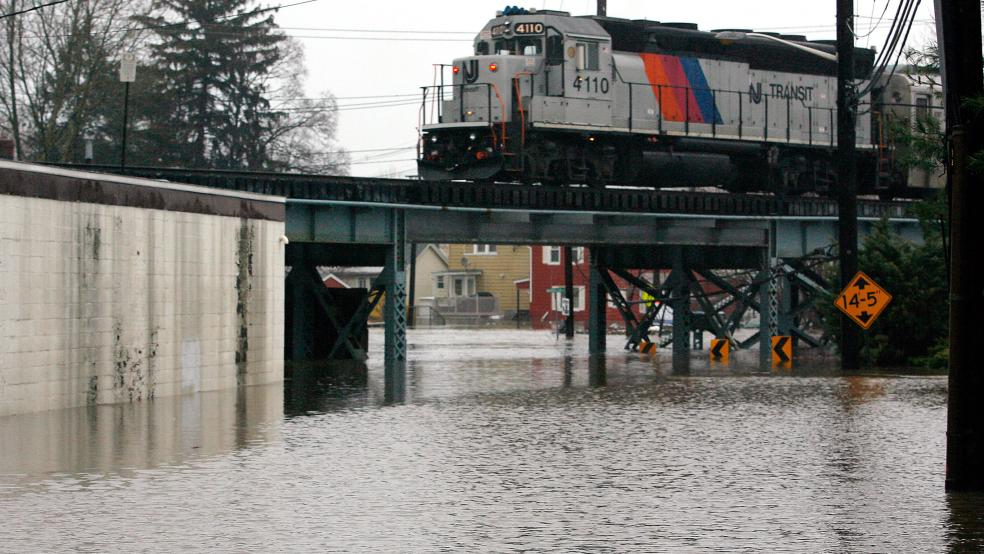The federal government’s failure to invest in the country’s infrastructure has become such a significant concern to professional planners that both national and international organizations regularly rate the U.S. among the worst developed countries in terms of its maintenance of roads, ports, rail transit, and the electrical grid. Even so, barring major power outages or high-profile bridge collapses, the country’s crumbling infrastructure rarely penetrates the consciousness of the general public.
Related: Why Infrastructure Investment Is a No-Brainer
That may be about to change, however, in one of the nation’s most critically important metropolitan areas. Commuters who travel from New Jersey to New York via the rail tunnels under the Hudson River learned last week that the four tracks under the river, which currently carry some 400,000 people to and from Manhattan every weekday, are in need of serious repairs. The two tunnels they pass through were badly damaged by Hurricane Sandy in 2012, and they will need to be shut down for a year at a time.
The problem is that the transit authorities that serve the New York-New Jersey metro area have been starved of the funding necessary to keep public transportation systems functioning at the level the region needs. The existing Hudson River tunnels have been operating at capacity for years, meaning that even the slightest disruption can cripple the system, despite the fact that politicians have understood for years the region’s critical need for expanded rail infrastructure.
Estimates are that shutting down one tunnel completely would reduce service not by half, but by 75 percent. Now Amtrak, which along with New Jersey Transit operates most of the commuter trains that use the tunnels, is calling for the construction, on what amounts to an emergency basis, of what it calls the “Gateway Project,” a $13 billion-plus plan to put more tracks under the Hudson between New Jersey and lower Manhattan.
Construction of Gateway would ease the burden on the existing tunnels, but even in the unlikely event that it gets speedy approval, would take many years to happen. The existing tunnels can be patched up well enough to survive for a few more years in their current condition, making Gateway a feasible, if unlikely, solution. Left unsaid is what would happen if another major storm like Sandy struck the region before Gateway is complete.
Related: American Infrastructure Gets a New Wakeup Call
Angie Schmitt, editor of the StreetsBlog Network, which covers transportation reform, said that the dilemma surrounding the Hudson River crossing illustrates a recurring problem in infrastructure planning: The degree to which politicians prioritize roads over other public transportation options.
“Transit gets the short end of the stick a lot of the time,” she said. In much of the country, politicians face a lot of pressure to improve highway infrastructure. Often, projects that would improve rail transport go begging.
That rings particularly true in New Jersey, where Governor Chris Christie in 2010 cancelled the construction of a major new tunnel system under the Hudson, known as the Access to the Region’s Core, or ARC project. Christie redirected funds for the ARC project to highway programs.
The ARC tunnel would only have reduced the pressure on the other Hudson rail tunnels slightly, but it illustrates one of the broader problems with how we allocate funds for infrastructure improvement.
Related: Spending on Infrastructure Now Generates Long-Term Jobs Later
“In some places you’ll hear the argument that only a fraction of the population uses transit, which may or may not be a good argument,” she said. “But in New York, it’s obviously not a good argument. The city completely depends on it. Still, even in New York the city is constantly nickel and diming the [Metropolitan Transit Authority]. They are still constantly scrounging for money to do transit projects.”
The problem in the New York Metro area is a reflection of a broader issue in the U.S. Too often, say experts, political inertia allows existing systems to be pushed to the breaking point before they are improved or expanded.
“Some examples are the water infrastructure in the desert Southwest and the power infrastructure in the Southeast,” said Robert Puentes, a senior fellow in the Brookings Institution’s Metropolitan Policy Program. Both have been pushed to the point where single points of failure can create a cascade of problems.
And, in part because of how long many of these shortcomings have been allowed to fester, they have another thing in common with the issue of Hudson River rail crossings.
As Schmitt puts it, “It’s going to be an expensive problem to solve.”
Top Reads from The Fiscal Times:





